Wenchao Du
Affective Behavior Analysis using Task-adaptive and AU-assisted Graph Network
Jul 16, 2024Abstract:In this paper, we present our solution and experiment result for the Multi-Task Learning Challenge of the 7th Affective Behavior Analysis in-the-wild(ABAW7) Competition. This challenge consists of three tasks: action unit detection, facial expression recognition, and valance-arousal estimation. We address the research problems of this challenge from three aspects: 1)For learning robust visual feature representations, we introduce the pre-trained large model Dinov2. 2) To adaptively extract the required features of eack task, we design a task-adaptive block that performs cross-attention between a set of learnable query vectors and pre-extracted features. 3) By proposing the AU-assisted Graph Convolutional Network(AU-GCN), we make full use of the correlation information between AUs to assist in solving the EXPR and VA tasks. Finally, we achieve the evaluation measure of \textbf{1.2542} on the validation set provided by the organizers.
Iterative Reconstruction Based on Latent Diffusion Model for Sparse Data Reconstruction
Jul 22, 2023



Abstract:Reconstructing Computed tomography (CT) images from sparse measurement is a well-known ill-posed inverse problem. The Iterative Reconstruction (IR) algorithm is a solution to inverse problems. However, recent IR methods require paired data and the approximation of the inverse projection matrix. To address those problems, we present Latent Diffusion Iterative Reconstruction (LDIR), a pioneering zero-shot method that extends IR with a pre-trained Latent Diffusion Model (LDM) as a accurate and efficient data prior. By approximating the prior distribution with an unconditional latent diffusion model, LDIR is the first method to successfully integrate iterative reconstruction and LDM in an unsupervised manner. LDIR makes the reconstruction of high-resolution images more efficient. Moreover, LDIR utilizes the gradient from the data-fidelity term to guide the sampling process of the LDM, therefore, LDIR does not need the approximation of the inverse projection matrix and can solve various CT reconstruction tasks with a single model. Additionally, for enhancing the sample consistency of the reconstruction, we introduce a novel approach that uses historical gradient information to guide the gradient. Our experiments on extremely sparse CT data reconstruction tasks show that LDIR outperforms other state-of-the-art unsupervised and even exceeds supervised methods, establishing it as a leading technique in terms of both quantity and quality. Furthermore, LDIR also achieves competitive performance on nature image tasks. It is worth noting that LDIR also exhibits significantly faster execution times and lower memory consumption compared to methods with similar network settings. Our code will be publicly available.
Hierarchical Disentangled Representation for Invertible Image Denoising and Beyond
Jan 31, 2023


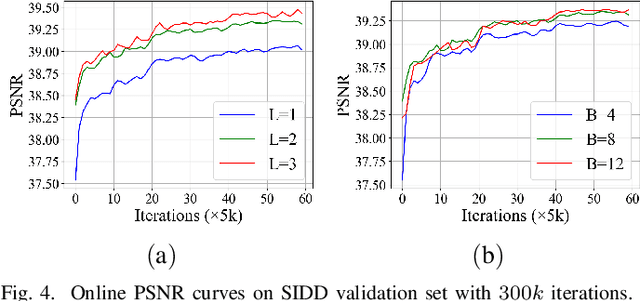
Abstract:Image denoising is a typical ill-posed problem due to complex degradation. Leading methods based on normalizing flows have tried to solve this problem with an invertible transformation instead of a deterministic mapping. However, the implicit bijective mapping is not explored well. Inspired by a latent observation that noise tends to appear in the high-frequency part of the image, we propose a fully invertible denoising method that injects the idea of disentangled learning into a general invertible neural network to split noise from the high-frequency part. More specifically, we decompose the noisy image into clean low-frequency and hybrid high-frequency parts with an invertible transformation and then disentangle case-specific noise and high-frequency components in the latent space. In this way, denoising is made tractable by inversely merging noiseless low and high-frequency parts. Furthermore, we construct a flexible hierarchical disentangling framework, which aims to decompose most of the low-frequency image information while disentangling noise from the high-frequency part in a coarse-to-fine manner. Extensive experiments on real image denoising, JPEG compressed artifact removal, and medical low-dose CT image restoration have demonstrated that the proposed method achieves competing performance on both quantitative metrics and visual quality, with significantly less computational cost.
Depth Completion using Geometry-Aware Embedding
Mar 21, 2022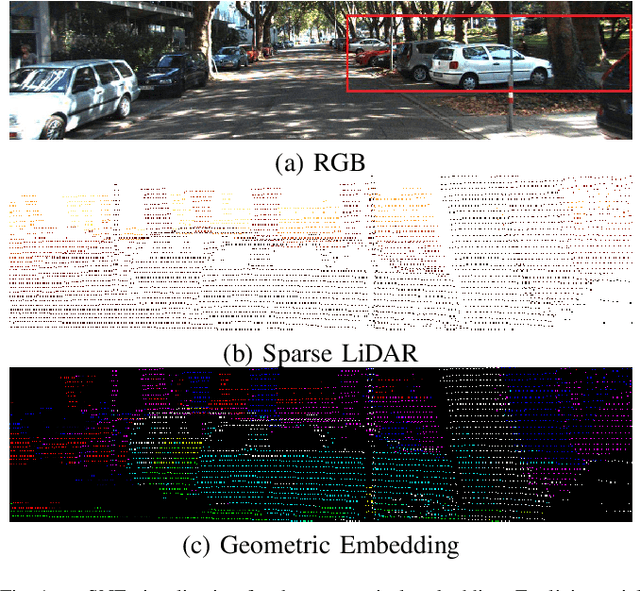

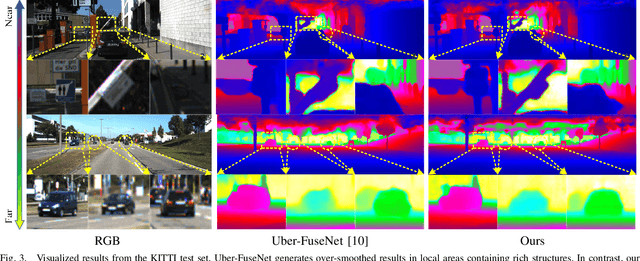
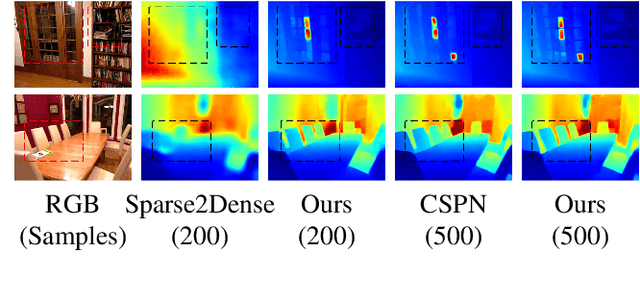
Abstract:Exploiting internal spatial geometric constraints of sparse LiDARs is beneficial to depth completion, however, has been not explored well. This paper proposes an efficient method to learn geometry-aware embedding, which encodes the local and global geometric structure information from 3D points, e.g., scene layout, object's sizes and shapes, to guide dense depth estimation. Specifically, we utilize the dynamic graph representation to model generalized geometric relationship from irregular point clouds in a flexible and efficient manner. Further, we joint this embedding and corresponded RGB appearance information to infer missing depths of the scene with well structure-preserved details. The key to our method is to integrate implicit 3D geometric representation into a 2D learning architecture, which leads to a better trade-off between the performance and efficiency. Extensive experiments demonstrate that the proposed method outperforms previous works and could reconstruct fine depths with crisp boundaries in regions that are over-smoothed by them. The ablation study gives more insights into our method that could achieve significant gains with a simple design, while having better generalization capability and stability. The code is available at https://github.com/Wenchao-Du/GAENet.
Learning Invariant Representation for Unsupervised Image Restoration
Mar 28, 2020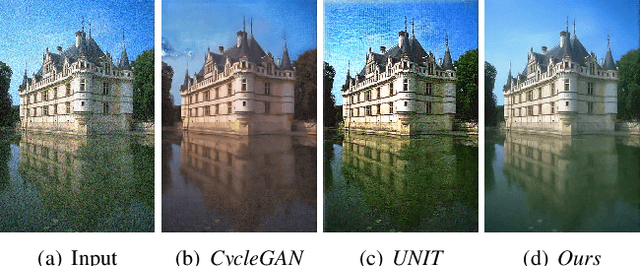
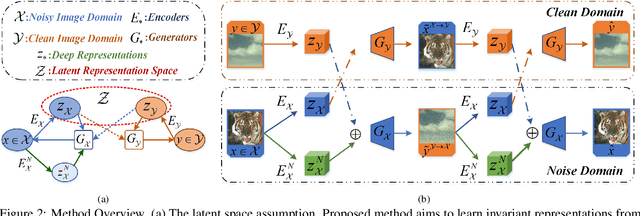
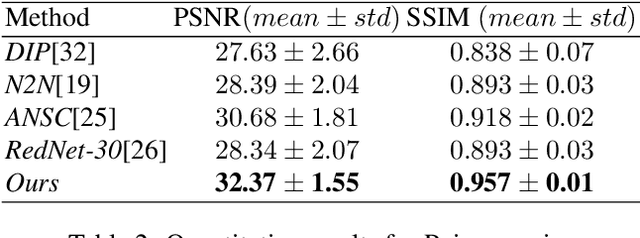
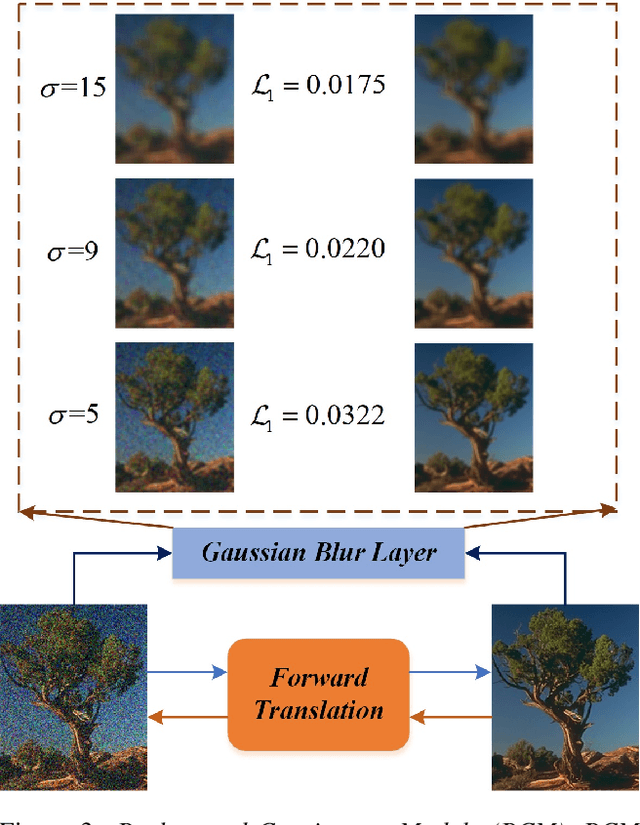
Abstract:Recently, cross domain transfer has been applied for unsupervised image restoration tasks. However, directly applying existing frameworks would lead to domain-shift problems in translated images due to lack of effective supervision. Instead, we propose an unsupervised learning method that explicitly learns invariant presentation from noisy data and reconstructs clear observations. To do so, we introduce discrete disentangling representation and adversarial domain adaption into general domain transfer framework, aided by extra self-supervised modules including background and semantic consistency constraints, learning robust representation under dual domain constraints, such as feature and image domains. Experiments on synthetic and real noise removal tasks show the proposed method achieves comparable performance with other state-of-the-art supervised and unsupervised methods, while having faster and stable convergence than other domain adaption methods.
Visual Attention Network for Low Dose CT
Oct 31, 2018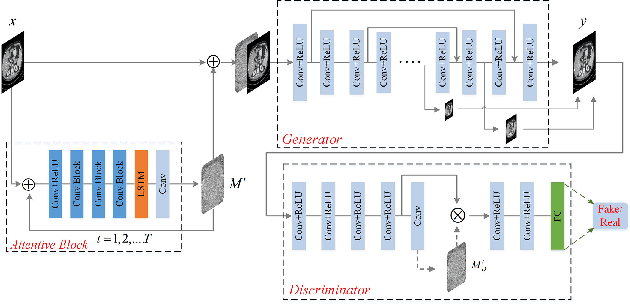
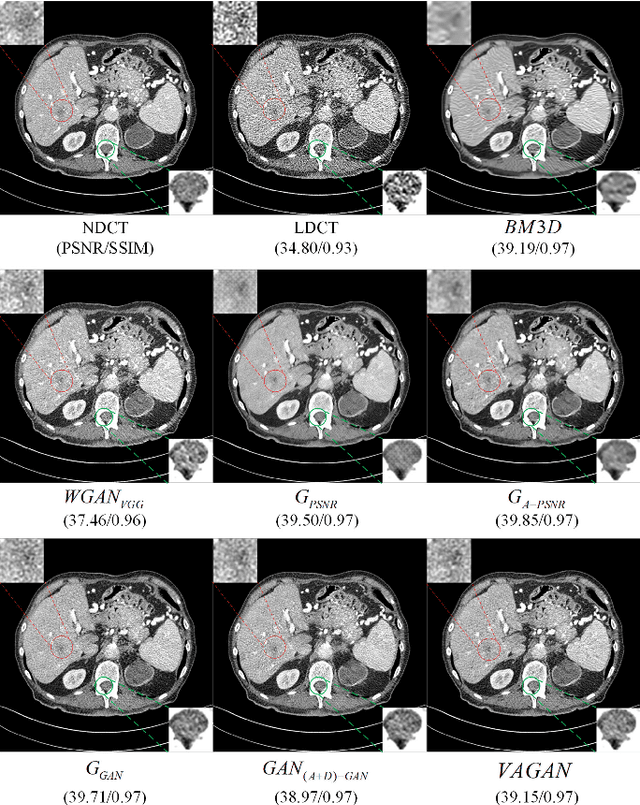
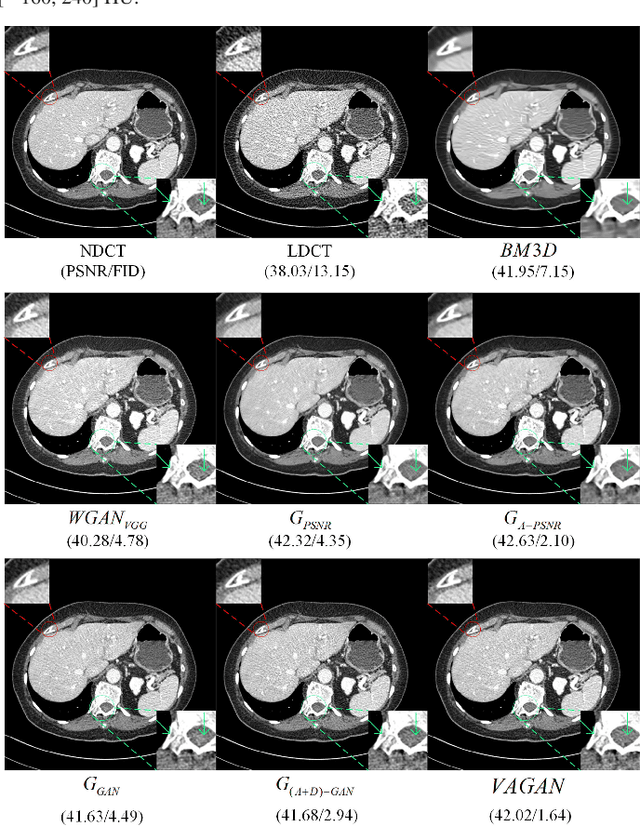
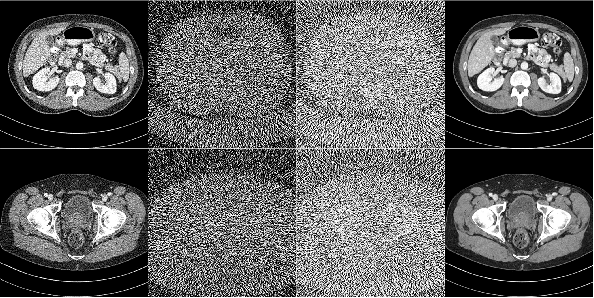
Abstract:Noise and artifacts are intrinsic to low dose CT (LDCT) data acquisition, and will significantly affect the imaging performance. Perfect noise removal and image restoration is intractable in the context of LDCT due to the statistical and technical uncertainties. In this paper, we apply the generative adversarial network (GAN) framework with a visual attention mechanism to deal with this problem in a data-driven/machine learning fashion. Our main idea is to inject visual attention knowledge into the learning process of GAN to provide a powerful prior of the noise distribution. By doing this, both the generator and discriminator networks are empowered with visual attention information so they will not only pay special attention to noisy regions and surrounding structures but also explicitly assess the local consistency of the recovered regions. Our experiments qualitatively and quantitatively demonstrate the effectiveness of the proposed method with clinic CT images.
Data Augmentation for Neural Online Chat Response Selection
Sep 03, 2018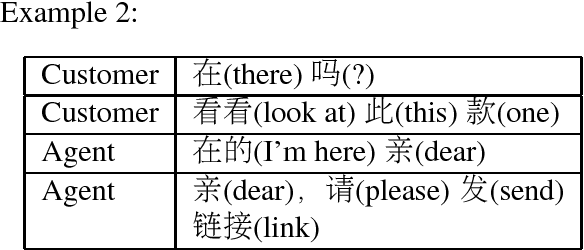
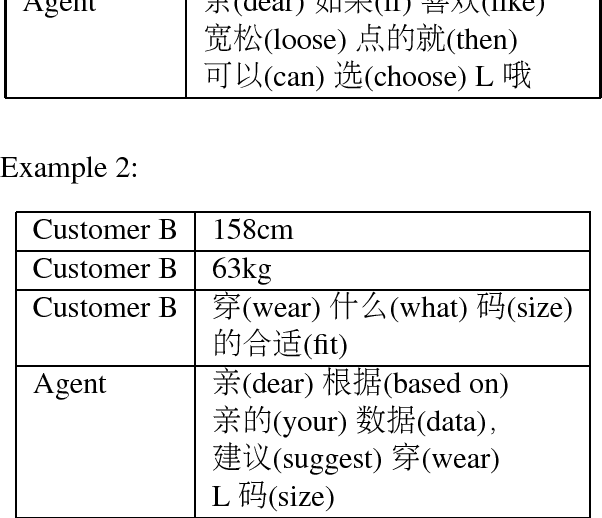
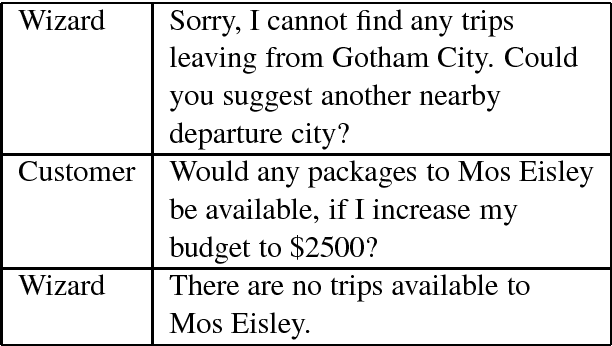
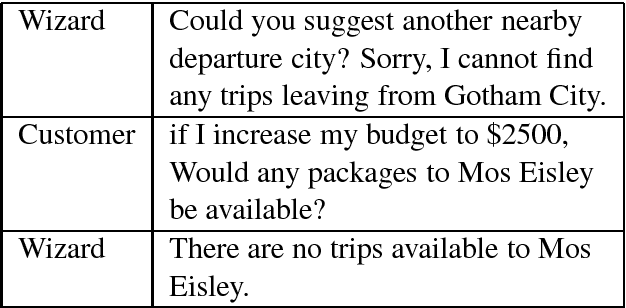
Abstract:Data augmentation seeks to manipulate the available data for training to improve the generalization ability of models. We investigate two data augmentation proxies, permutation and flipping, for neural dialog response selection task on various models over multiple datasets, including both Chinese and English languages. Different from standard data augmentation techniques, our method combines the original and synthesized data for prediction. Empirical results show that our approach can gain 1 to 3 recall-at-1 points over baseline models in both full-scale and small-scale settings.
Discovering Conversational Dependencies between Messages in Dialogs
Dec 08, 2016

Abstract:We investigate the task of inferring conversational dependencies between messages in one-on-one online chat, which has become one of the most popular forms of customer service. We propose a novel probabilistic classifier that leverages conversational, lexical and semantic information. The approach is evaluated empirically on a set of customer service chat logs from a Chinese e-commerce website. It outperforms heuristic baselines.
 Add to Chrome
Add to Chrome Add to Firefox
Add to Firefox Add to Edge
Add to Edge